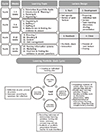Abstract
Purpose
This study was conducted to examine effects of a learning portfolio by identifying the learning of nursing students taking a learning portfolio-utilized nursing management class.
Methods
A non-equivalent control group pretest-posttest design was used. Participants were 83 senior students taking the nursing management course in one of the Departments of Nursing at 2 Universities. Experimental group (n=42) received a learning portfolio-utilized nursing management class 15 times over 15 weeks (3 hours weekly). Self-directed learning abilities, approaches to learning and learning flow of the participants were examined with self-report structured questionnaires. Data were collected between September 2 and December 16, 2014, and were analyzed using chi-square test, Fisher's exact test, independent t-test and ANCOVA with SPSS/PC version 21.0.
Results
After the intervention the experimental group showed significant increases in self-directed learning abilities, deep approaches to learning and learning flow compared to the control group. However, no significant difference was found between groups for surface approaches to learning.
Conclusion
Learning activities using the learning portfolios could be effective in cultivating the learning competency for growth of knowledge, technology and professionalism by increasing personal concentration and organization ability of the nursing students so that they can react to the rapidly changing environment.
Figures and Tables
References
1. Korean Accreditation Board of Nursing Education. Nurses' core competencies and nursing education learning outcomes [Internet]. Seoul: Author;2012. cited 2012 December 10. Available from: http://kabon.or.kr/HyAdmin/upload/goodFile/120121127132143.pdf.
2. Jang KS, Park SJ. Effects of action learning approaches on learning outcomes in nursing management courses. J Korean Acad Nurs Adm. 2012; 18(4):442–451. DOI: 10.11111/jkana.2012.18.4.442.
3. Kuisma R. Portfolio assessment of an undergraduate group project. Assess Eval High Educ. 2007; 32(5):557–569. DOI: 10.1080/02602930601116904.
4. Timmins F. Take time to facilitate self-directed learning. Nurse Educ Pract. 2008; 8(5):302–305. DOI: 10.1016/j.nepr.2008.02.004.
5. Timmins F, Dunne PJ. An exploration of the current use and benefit of nursing student portfolios. Nurse Educ Today. 2009; 29(3):330–341. DOI: 10.1016/j.nedt.2008.12.010.
6. Buckley S, Coleman J, Davison I, Khan KS, Zamora J, Malick S, et al. The educational effects of portfolios on undergraduate student learning: A best evidence medical education (BEME) systematic review. BEME Guide No. 11. Med Teach. 2009; 31(4):282–298. DOI: 10.1080/01421590902889897.
7. Zubizarreta J, Millis BJ. The learning portfolio: Reflective practice for improving student learning. 2nd ed. San Francisco, CA: Jossey-Bass;2009.
8. Van Tartwijk J, Driessen EW. Portfolios for assessment and learning: AMEE Guide no. 45. Med Teach. 2009; 31(9):790–801. DOI: 10.1080/01421590903139201.
9. Baeten M, Dochy F, Struyven K. Students’ approaches to learning and assessment preferences in a portfolio-based learning environment. Instr Sci. 2008; 36(5):359–374. DOI: 10.1007/s11251-008-9060-y.
10. Kicken W, Brand-Gruwel S, van Merriënboer , Slot W. Design and evaluation of a development portfolio: How to improve students’ self-directed learning skills. Instr Sci. 2009; 37(5):453–473. DOI: 10.1007/s11251-008-9058-5.
11. Mofrad MN, Karami M. The effects of portfolio method on self-directed learning (SDL) of nursing students. Biosci Biotechnol Res Asia. 2013; 10(2):817–821. DOI: 10.13005/bbra/1201.
12. Jones E. A professional practice portfolio for quality learning. High Educ Q. 2010; 64(3):292–312. DOI: 10.1111/j.1468-2273.2010.00458.x.
13. Kear ME, Bear M. Using portfolio evaluation for program outcome assessment. J Nurs Educ. 2007; 46(3):109–114.
14. Park SH, Bae SH. A case study about the learning competency for students through learning portfolio. J Learner-Centered Curric Instruction. 2008; 8(2):159–179.
15. Bahreini M, Moattari M, Shahamat S, Dobaradaran S, Ravanipour M. Improvement of Iranian nurses’ competence through professional portfolio: A quasi-experimental study. Nurs Health Sci. 2013; 15(1):51–57. DOI: 10.1111/j.1442-2018.2012.00733.x.
16. Park HG. An analysis of the mediating effect of the learning flow in the relationship between study motivation factors and self-directed learning [dissertation]. Seoul: Hong-Ik University;2010.
17. Lee JH. Analysis of the structural relationships among self-determination motivation to learn, metacognition, self-directed learning ability, learning flow, and school achievement. Korean J Educ Res. 2010; 48(2):67–92.
18. Kim A, Tack H, Lee CH. The development and validation of a learning flow scale for adults. Korean J Educ Psychol. 2010; 24(1):39–59.
19. Kim EK, Kim SY, Jung MS, Jang KS, Kim J, Kim JK, et al. Current status and considerations for education in nursing management. J Korean Acad Nurs Adm. 2011; 17(2):238–246. DOI: 10.11111/jkana.2011.17.2.238.
20. Rossetti J, Oldenburg N, Fisher-Robertson J, Coyer SM, Koren ME, Peters B, et al. Creating a culture of evidence in nursing education using student portfolios. Int J Nurs Educ Scholarsh. 2012; Forthcoming.
21. Lee SJ, Chang YK, Lee HN, Park KY. A study on the development of life-skills: Communication, problem solving, and self-directed learning. Report No.: RR 2003-15-3. Seoul: Korean Education Development Institute;2003.
22. Biggs J, Kember D, Leung DY. The revised two-factor study process questionnaire: R-SPQ-2F. Br J Educ Psychol. 2001; 71(Pt 1):133–149.
23. Hwang SJ. The effect of utilization of learning portfolios on approaches to learning and learners' perception [master's thesis]. Andong: Andong National University;2011.
24. Tompkins M, Paquette-Frenette D. Learning portfolio models in health regulatory colleges of Ontario, Canada. J Contin Educ Health Prof. 2010; 30(1):57–64. DOI: 10.1002/chp.20057.
25. Zubizarreta J. The learning portfolio: Reflective practice for improving student learning. Bolton, MA: Anker;2004.
26. Yang JH, Yang B. Nursing students’ experiences with facilitator in problem-based learning class. Asian Nurs Res. 2013; 7(4):198–204. DOI: 10.1016/j.anr.2013.10.002.
27. Struyven K, Dochy F, Janssens S. Students’ perceptions about evaluation and assessment in higher education: A review. Assess Eval High Educ. 2005; 30(4):325–341. DOI: 10.1080/02602930500099102.
28. LoBiondo-Wood G, Haber J. Nursing research: Methods and critical appraisal for evidence-based practice. 8th ed. St. Louis, MO: Mosby;2014.
29. Park HJ, Byun HS. Experiences on application of learning portfolio in nursing students. J Korean Acad Soc Nurs Educ. 2014; 20(4):534–547. DOI: 10.5977/jkasne.2014.20.4.534.
30. McMullan M. Using portfolios for clinical practice learning and assessment: The pre-registration nursing student’s perspective. Nurse Educ Today. 2008; 28(7):873–879. DOI: 10.1016/j.nedt.2007.11.006.




 PDF
PDF ePub
ePub Citation
Citation Print
Print






 XML Download
XML Download